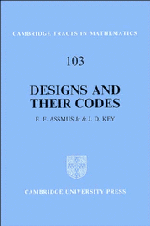6 - Codes from planes
Published online by Cambridge University Press: 05 October 2015
Summary
Introduction
We have already met some projective planes in their roles as symmetric designs with λ = 1, i.e. designs with parameters (n2 + n + l,n + 1,1). Moreover, we have constructed the classical projective planes, PG2﹛F), F being a field; in fact, F could have been a division ring. But, historically, they arose synthetically or, in other words, via an axiomatic treatment. The undefined terms were “point”, “line” and “incident” and, besides an axiom designed to eliminate trivial cases, the axioms were simply that any two distinct points are incident with a unique line and that any two distinct lines are incident with a unique point. These axioms are duals of one another in the sense that interchanging “point” and “line” interchanges the two axioms. The principle of duality then states that in any theorem concerning projective planes, the statement obtained by interchanging the words “point” and “line” is also a theorem concerning projective planes.
Likewise, we have met some affine planes, i.e. designs with parameters 2-(n2,n, 1). These also arose synthetically, the undefined terms being the same, but the axioms less elegant. Again leaving aside the axiom eliminating trivial cases, the axioms stated that any two distinct points are incident with a unique line, but the dual axiom was replaced by an axiom which we will specify shortly. It was the inelegance that arose from the lack of duality (among other things) that led geometers to treat projective planes with more respect and to go (usually) directly to the projective completion when confronted with an affine plane. One notable exception to the preference for projective over afRne was amongst those mathematicians interested in translation planes. The coding-theoretical approach we adopt here makes it quite clear why this was so.
In an affine plane two distinct lines are incident with at most one point; two distinct lines are said to be parallel if there is no point incident with both. The famous parallel postulate that given a line and a point not incident with it there is a unique line incident with the given point and parallel to the given line replaces the other projective axiom. Allowing a line to be parallel to itself, parallelism is then an equivalence relation on the set of all lines, defining distinct parallel classes.
Information
- Type
- Chapter
- Information
- Designs and their Codes , pp. 199 - 248Publisher: Cambridge University PressPrint publication year: 1992
